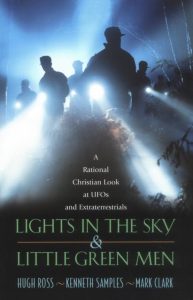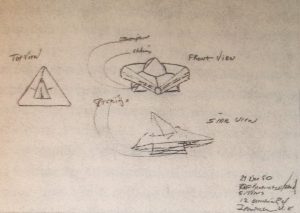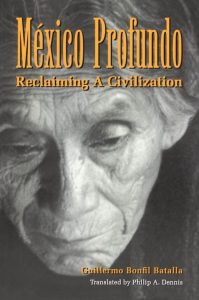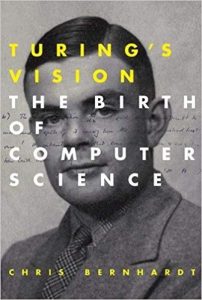Lights In The Sky & Little Green Men
Lights In The Sky & Little Green Men, A Rational Christian Look at UFOs and Extraterrestrials, by Hugh Ross, Kenneth Samples, and Mark Clark. The book is published by NavPress, Bringing Truth to Life, Colorado Springs, Colorado, 2002.
In addition to numerous other qualifications in education, Hugh Ross has received master’s and Ph.D degrees in astronomy, Kenneth Samples has a master’s degree in theological studies, and Mark T. Clark is a Professor Emeritus of political science. The authors are active in Reasons to Believe, “a nonprofit organization providing research, publications, and teaching on the harmony of God’s revelation in the words of the Bible and in the facts of nature.” There is no hesitation in this compact book of 255 pages to take on the worst human UFO-related disasters of the twentieth century and point directly to the cause, which is demonic.
In the Preface, Hugh Ross writes “Speculations about unidentified flying objects and extraterrestrial beings just won’t go away. They continue to crop up in conversations all over the planet. Almost everyone can tell a story of seeing weird lights in the sky – lights that seem to defy explanation.” Little green men are those beings who fly overhead in spaceships, sometimes landing. “We hope this book will compel people to explore beyond surface explanations.”
Kenneth Samples opens the first chapter with references to sightings from antiquity through the twentieth century, with an increase of sightings by pilots during World War II, who speculated that these anomalies, called “Foo Fighters,” were advanced enemy aircraft. “From the late 1940s through the 1960s, the United States Air Force investigated UFO reports through various projects and committees, concluding with the “Condon Report,” which states that “further extensive study of UFOs probably cannot be justified in the expectation that science will be advanced thereby.” However, the subject has obviously not gone away and has continued to be carried, e.g., by NASA’s SETI (Search for Extraterrestrial Intelligence), professional ufologists, social scientists, UFO enthusiasts and debunkers, New Agers, UFO cult members, and Christian theologians and apologists.
Author Kenneth Samples examines Types of UFOs in Chapter 2. “There are plenty of crackpot UFO enthusiasts out there, but many ufologists are respected scientists and other experts who are going about their task in a professional way.” Subheadings in this chapter include Systems of Classification, Natural Explanations, and Two Leading Hypotheses. The hypotheses for the phenomena are extraterrestrial (ETH) – the most popular explanation among Americans – and interdimensional (IDH). Regarding the IDH, this is “sometimes described as the paranormal or occult view of UFOs. Some ufologists, (especially Christians) have ascribed an angelic or demonic interpretation to this interdimensional presence. Even a number of leading secular ufologists have argued for a correspondence between UFO phenomena and the occult or demonism.” Significantly, the authors refer throughout the book to the concept of the RUFO, or the residual UFO, “those unexplainable yet real phenomena that remain after all naturalistic explanations have been exhausted.” The “Condon Report” aside, there should be much to learn about cosmic and human existence – as this book testifies – from UFOs and RUFOs. (RUFOs are later described as “both real and nonphysical” in a chapter titled A Closer Look at RUFOs.)
As Hugh Ross writes in Chapter 9, Nature and Subnature, “Ever since publication of Robert Jastrow’s landmark volume, God and the Astronomers, in 1978, references to the supernatural – and specifically to God and theology – have become commonplace in books by astronomers and physicists. If a person scans the science shelves at a local bookstore, he will find books with titles like God and the New Physics, The God Particle, God and the Cosmologists, Reading the Mind of God and Through a Universe Darkly. What’s going on here? Is a mass conversion taking place? No, it’s not a mass conversion. Rather, this development arises from research findings. A mountain of evidence compels the conclusion that reality must exist beyond the physical universe.” Under one of this chapter’s subheadings, The Nature of Supernature, Hugh Ross writes, “For those who care to investigate, nature holds abundant clues to its supernatural source or cause. And that investigation may hold keys to unlocking some of the mysteries of UFO phenomena.”
Mark Clark tackles Government Cover-Ups in Chapter 7. “True believers in UFOs are frustrated at not being able to convince the world that a residual portion of UFO sightings are for real. Could someone be making their task more difficult?” The U.S. Government. “And so the loaded word ‘cover-up’ enters the conversation.” He continues on with the subjects of Roswell, the Classified Information that came out of the Cold War, Project Blue Book (the Air Force response), the CIA, and Bureaucratic Politics. Then a second full chapter, Government Conspiracies, includes the topics of Political Culture, The Psychological Dynamic, Contrary Evidence, Popular Opinion and the Ockham’s Razor dictum.
This is a remarkable book that should be on the shelf of every conscientious twenty-first century citizen. It is not easy to read through Chapter 14 on UFO Cults by Kenneth Samples, where he describes The Aetherius Society, The Unarius Academy of Science, Heaven’s Gate, and The Raelian Movement. These unimaginably horrible realities of human behavior and error are followed by The Bible and UFOs, Chapter 15 – quoting Ezekiel 1:4-28;10, 2 Kings 2:1-12, and Revelation 1:12-18 – and a Summary, Chapter 16, stating that “RUFOs … are consistent with the Bible’s descriptions of demons.” Adhering to the “doctrinal statements of the National Association of Evangelicals and the International Council on Biblical Inerrancy,” Reasons to Believe has admirably taken on the UFO phenomena. The book concludes with three Appendixes (e.g., Appendix A, Fine Tuning for Life on Earth), extensive Notes, a Bibliography, and Subject and Name Indexes. – Martha Keltz
References:
The Incarnation of Ahriman: The Embodiment of Evil on Earth: Seven Lectures by Rudolf Steiner, Given Between October and December, 1919, Skylark Books, on Amazon.com.
Astronomy and Spiritual Science, The Astronomical Letters of Elisabeth Vreede, SteinerBooks, on Amazon.com.
On-Line references:
Cosmic Christianity & The Changing Countenance of Cosmology: https://wn.astrosophy.science/Books/Cosmic/Cosmic_index.html
The Ahrimanic Deception: https://wn.rudolfsteinerelib.org/Lectures/AhrDec_index.html
The Influences of Lucifer and Ahriman: https://wn.rudolfsteinerelib.org/Lectures/GA191/English/AP1993/InLuAr_index.html
The Cosmic New Year: https://wn.rudolfsteinerelib.org/Lectures/GA195/English/RSPC1938/CosNew_index.html
The Mission of the Archangel Michael: https://wn.rudolfsteinerelib.org/Lectures/MissMich/MisMic_index.html






